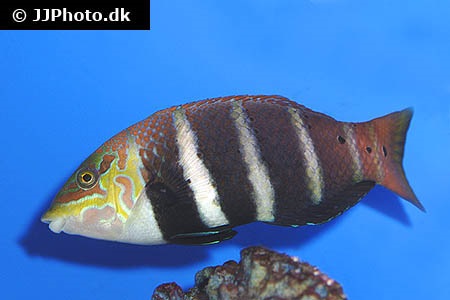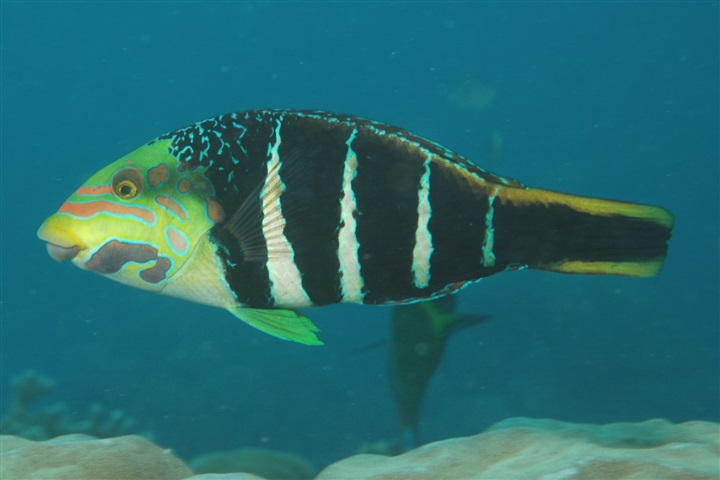Hemigymnus fasciatus


| Latin name | Hemigymnus fasciatus - (Bloch, 1792) |
|---|---|
| Local name | Barred thicklip |
| Family | Labridae - Hemigymnus |
| Origin | East Indian Ocean, West Indian Ocean, Australia, The Red Sea, Indonesia, East Pacific, Central/West Pacific |
| Max length | 30 cm (11.8") |
| Minimum volume |
1500 l (396 gal) |
|---|---|
| Hardiness |
Delicate |
| Suitable for aquarium |
Experience, preparation and extra care required |
| Reef safe |
Not reef safe |
| Aggressiveness | Might be aggressive towards similar species |
| Recommended |
Larger crustaceans (Shrimp, crabs...) Other invertebrates Small crustaceans (Krill, mysis, artemia...) |
|---|
This species requires feeding 4 or more times a day.
This species eats shrimps, crayfish, crabs, small bivalves, sea urchins, snails and similar.
This species searches through the sand for food, which can make the water cloudy and shakes up detritus.
In an aquarium their natural food source in the sand is quickly exhausted.
This species needs a very large aquarium when fully grown.
Exactly how big the aquarium should be is hard to say, but the size of this species is such, that it cannot normally be kept in a home aquarium.
This species is very sensitive during transportation and acclimatizing into the aquarium.
There is a greater chance of success with this species if one can supply a living feed to allow it to adapt to the tank.
This species will better acclimatize to the aquarium`s condition if introduced, when young.
Very small individuals can be very delicate.
This species revels in swimming and requires an aquarium with ample space.
This species can change gender from female to male.
When a male is needed, a female changes sex and takes on the role.
Fish in the Hemigymnus grow to be very large, and therefore require a spacious tank.
They are typically fairly peaceful towards other fish, but do pose a threat to many invertebrates.
They must be fed four times a day, which requires good filtration.
Before purchasing these fish one must be aware that they often cover corals with sand, in their search for food.
Wrasses are nearly always seen in reef aquaria, since many of the species are both attractive and useful in battling a range of unwanted invertebrates like i.e. flatworms, pyramide snails.
These fish live of everything from zooplankton to large crustaceans, sea urchins and the like.
The needs and behaviour of Wrasses vary greatly, so it is vital to familiarize oneself with the specific species before buying one.
| Aquarium trade | Yes |
|---|---|
| Distribution | Indo-Pacific: Red Sea (Ref. 1602) south to Inhaca Island, Mozambique (Ref. 4392) and east to Tahiti. |
| French common names |
Tamarin à bandes noires Mamselle Adèle Chien noir |
| German common names |
Streifenbannerfisch |
| English common names |
Fiveband wrasse Five-banded wrasse Barred thicklip wrasse Barred thicklip Barred wrasse |
Bob Fenner. Genera Hemigymnus and Hologymnosus Wrasses - Wet Web Media - (English)
Scott W. Michael. 2009. Wrasses and Parrotfishes (Reef Fishes Series Book 5) - TFH Publications / Microcosm Ltd. - (English)

